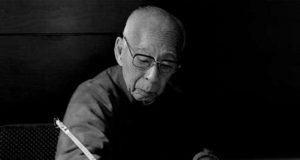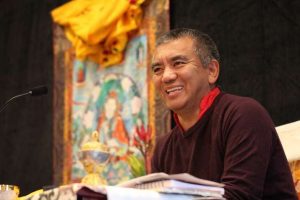The Yellow Emperor liked these crystal pools, these fickle waterfalls. They trickled but they also crashed. They fell towards him, droplets outstretched, or they squeezed themselves through the stones that peeked out from the cliffs. He enjoyed the mist that veiled the trees in the morningtide. A flick of the page; a turn of the centuries, and lo! Someone had built a house (?J?f) on the mountain at the twilight of the Shang Dynasty. When he promptly attained eternal life, the dwelling was left empty, and the mountain was promptly called “the Mountain of the House” (?f?s). (1)
For millennia, Chinese tradition has celebrated sacred mountains. Poems and epics have extolled their heights. Recluses and monks have scrambled up their peaks to settle there. Lu Mountain in Jiu Jiang (?E??) of Jiang Xi (????) province is particularly noted for its very early presence in the Chinese consciousness, dating back to the Zhou Dynasty (1046 BCE – 256 BCE) and further into the Neolithic period. The history of this mountain is so ancient, so primeval, that it is perhaps not surprising that it so many spiritual landmarks dot its many peaks and treescapes. Celebrated in Chinese literature as well as religion, its attraction was irresistible to many luminaries. It is one of the most dramatic echoes of the past, reaching out to our short memories with an arm as long as time itself.
On the mountain there are many peaks like Wu Lao, Xiang Lu, Hanyang, Bai Yun and Shuang Jian. There are valleys like Kang Wang, Qi Xian and Hu Xi. Caves like Bai Lu, Bai Yun and Lian Hua, and platforms like Bore, Fan Jing and Wen Shu. In its golden days, Lu Mountain had hundreds of Buddhist temples; today, only around 80 survive, including Dong Lin, Xi Lin, Gui Zong, Kai Xian, Yuan Tong and Tian Chi, along with some historical sites like the hexagonal pagoda, the small stone pagoda with five levels, and the pagoda yard and tomb of Hui Yuan, the de facto founder of Chinese Pure Land Buddhism.
Lu Mountain is located at the crossing of rivers and lakes. To its north lies the Yangtze River, and Poyang Lake to its east. Legend suggests that the folk hero Da Yu (?j??) stopped the floods in Jiu Jiang, Peng and at Lu Mountain. In Sima Qian’s Book of History – Chapter of Rivers (written when he went to Lu Mountain to survey the terrain of mountains and rivers in BC 126), the historian records: ‘climbing Lu Mountain from the southern foot and watching Yu channeling the water’ (?l?n?n?f?s?A?[?겨?E??). Historical emperors, including Qin Shi Huang and Emperor Wu of the Han Dynasty, were addicted to the prospect of ‘The Elixir of Immortality’, which led to an upsurge of alchemists in that period of history. Consequently Lu Mountain, ‘steep and elegant, with Wu Lao Peak overlooking the lake and fountains falling from the sky, abundant medicinal herbs and placid animals’, became an important hub for alchemists’ activities (2). While they might not have found the secret of eternal life there, the mountain’s tea (?f?s??????) remains a celebrated import.
Under the reign of Emperor Ling (156 – 189) in the Eastern Han dynasty, the Parthian prince-turned monk An Shigao (?w?@??) visited Mount Lu. Many more teachers came. At the beginning of warlord Taiyuan’s reign (376 – 396) during the Eastern Jin Dynasty, Hui Yong, a student of Dao’an, came and built Xi Lin Temple in Xiang Valley. In 381, Hui Yuan was invited by Hui Yong to build Dong Lin Temple (3), the first true Pure Land monastery in China. In 402, the prajna Platform House was built to enshrine Amita?bha Buddha. The famous White Lotus Society was established with 120 monks and laypeople as a sanctuary for Pure Land students (4). From then onwards, more and more devotees came to the mountain, and it became a sacred pilgrimage spot for Pure Land believers.
The masters continued coming. Samghadeva came to popularize the Buddhist teaching and translate the Abhidharmasara and other scriptures. Buddhabhadra translated the Dharmatara dhyana-sutra here. Wang Xizhi, the great calligrapher, built Gui Zong Temple in the mountain and invited Buddhayas?as to live there. Lu Mountain rapidly became a center of attraction for sutra translation. For a period, it could even have been called the main center of Buddhism proper (5). Besides affiliated practitioners, famous people like Tao Yuanming and Lei Cizong also came to retire and withdraw from the outside world (6). This happy trend continued until the Jin warlord Huan Xuan forbade Buddhism and unleashed a wave of persecution, with only Lu Mountain spared from carnage and monastic banishment.
(1) Li Haiyan, Xu Xiaoxuan, and Li Ziqing,“Junxiu Lu Shan shenxian zhai”. Jiangxi Pictorial 2 (2009): 32.
(2) Feng Changming, Zhang Qin and Wang Yinghong,“Lu Shan fojiao lvyou kaifa yanjiu”. China Academic Journal Electronic Publishing House (2009): 217.
(3) Gu Nong, “Tao Yuanming Dui fojiao de taidu”, Shandong Shida Xuebao (1997): 93.
(4) Wang Juanxia, and Yang Yuqing,“Lun Dongjin Lu shan fojiao he shanshuiyouji de fazhan”,Journal of Xi’an University of Arts and Science 10 (2007): 17.
(5) Gao Huaping, “Tao Yuanming ru shi dao bianzheng tongyi de yishu renge”. Journal of Central China Normal University 41 (2002): 64.(6) Xu Longmei, and Xu Yanping,“Jinling Lidai Gaoseng Fashi Pu”, Jiangsu Difang Zhi (2009): 60.













